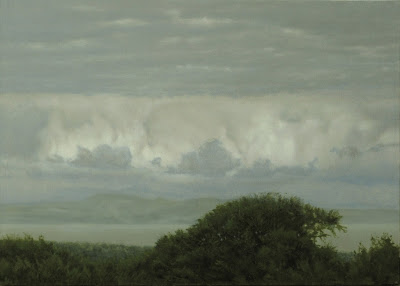oil on card 30x21cm
Nice little cloud study, from a photo I took in October when up Craiglockhart Hill. You’re facing broadly north-eastwards – you can see Fife across the Firth of Forth, and if you look closely there’s an indication of the Lomond Hills. It was just a quick snap of the light on the cumulus clouds, but I tweaked the foreground trees, and the near coast a bit, and I think I’ve ended up with quite an interesting little composition.
It would’ve been finished a couple of weeks ago, but I started it disastrously by not being able to get the tones and misty greys right – I was at least a couple of sessions down before I finally got to grips with them (which sounds ridiculous as it is such a tiny painting). The space between cloud ‘ceiling’ and the cumulus ‘wall’ is a little ill-defined and indistinct, but I could spend ages re-defining that so I think I’ll just leave it as is. Got there in the end though, and, as ever, the most successful bits of painting – the foreground trees – took the least bit of thought and trouble. There must be some way I can use that…
Not much else to say, really, except that the other week Madam and I went to the National Gallery of Scotland to see Carel Fabritius’ ‘The Goldfinch’ – which is on loan there from the Mauritshuis in The Hague. Earlier this year we’d actually been thinking about taking a little jaunt to Holland specifically to see it, then - who’d have thought – it turned up here in Edinburgh. It was on a special stand in the middle of the gallery, but cordoned off and only viewable from about six feet away from the front. Which was a little annoying. The real thing is very different from most of the reproductions I’ve seen. The colour is quite subdued - though the pale yellow wing flash leaps out – but I did get a new sense of how just cramped into the right side of the painting the bird is, and how it seems to sit in its own shadow. There is a theory that it’s designed to be a piece of trompe l'oeil – so true-to-life that you’re tricked into thinking it’s real - but I’m not so sure, as the shadows seem a little inconsistent. The perches are lit from above, but the main shadows seem to slant upwards. This indicates, to me, that the light source – probably a window - is below, which, cruelly, means that the bird cannot ever see the sky.
The ropes at the side allowed me to stand a bit closer and I was able to get a better look. The quickness of the drawing is superb. The painter has introduced a slight droop to the tail feathers, but as I leaned in close enough to focus clearly on the face I was shocked. This wee bird looking at me was so sad, so beaten, so hopeless. I can feel it still.
The picture was painted in 1654. I saw it in 2016, and it reached out.
That is what very good painting can do…
